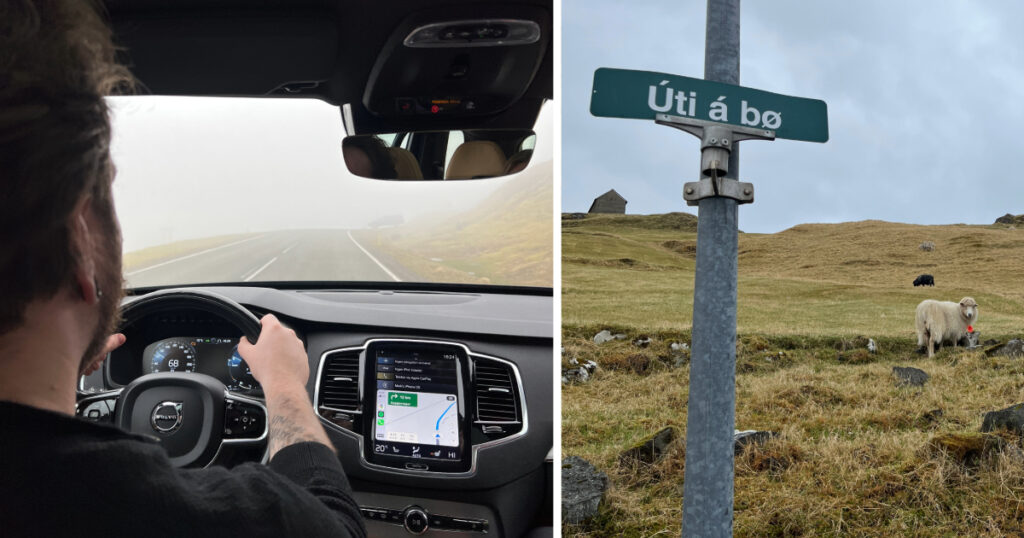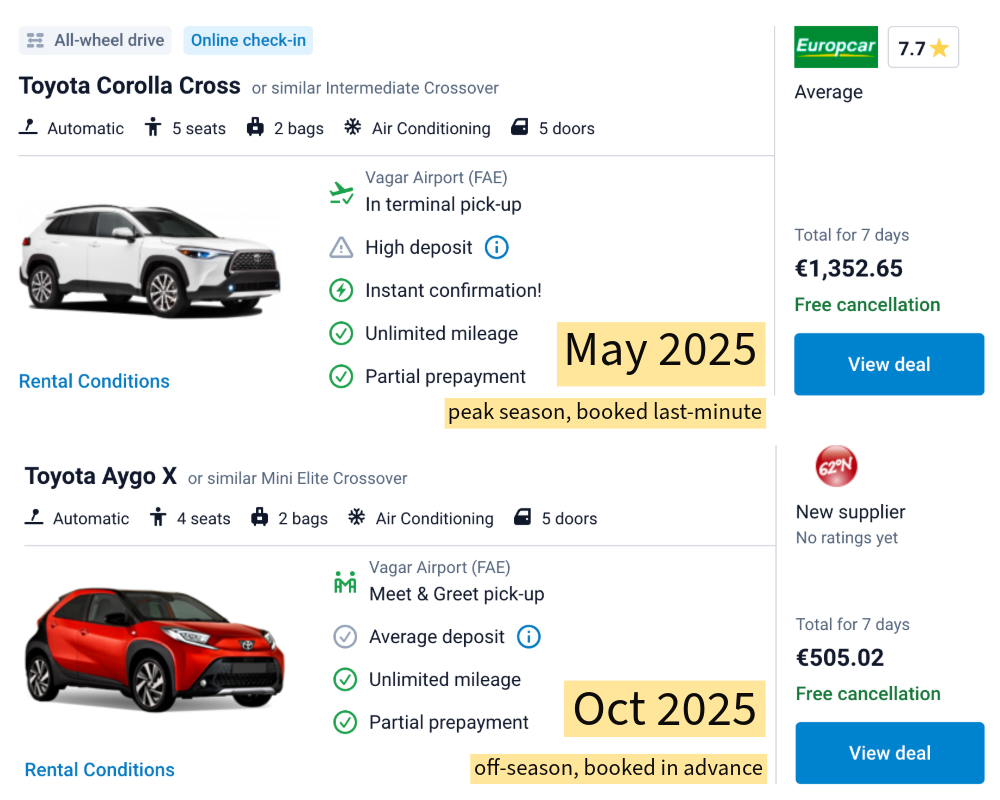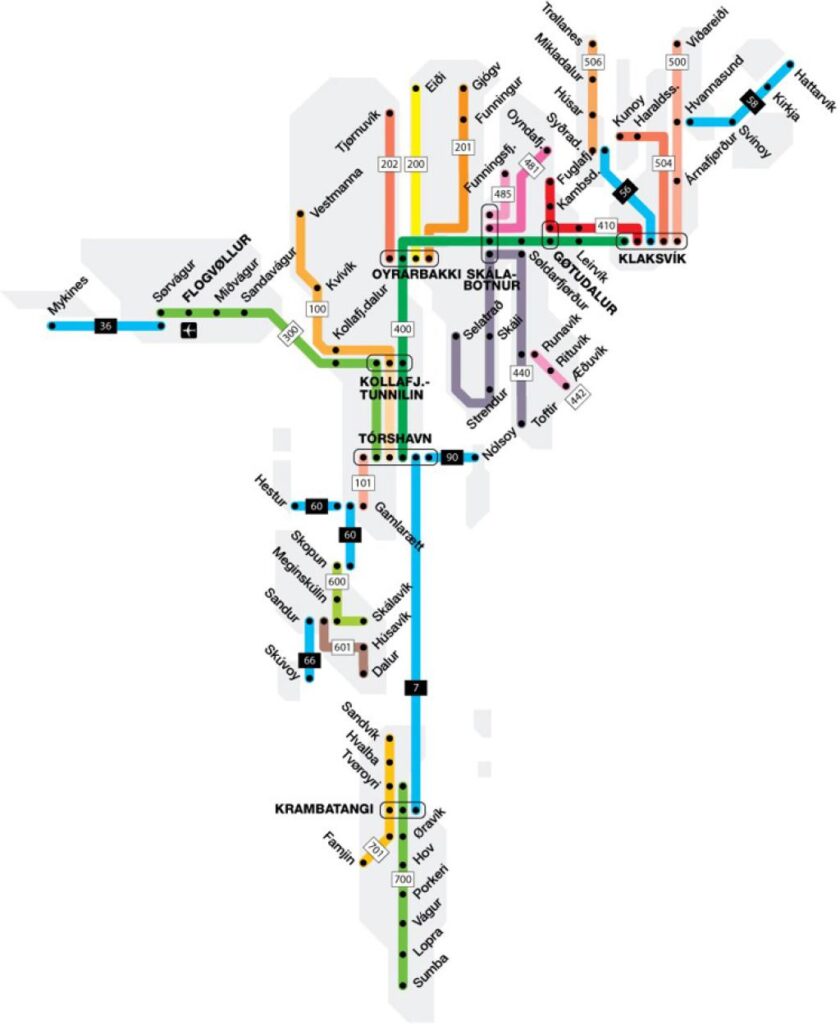One of the most important decisions you’ll make when planning a trip is whether to rent a car in the Faroe Islands — and if you ask me, it’s a resounding “yes.” The real magic of this remote destination lies in its stunning cliffs, winding coastal roads, and tiny villages that are best (and sometimes only) accessible by car. Without your own set of wheels, you won’t have the same freedom to explore at your own pace and may waste time standing at the bus stop. Here’s everything you need to know about organizing a car hire in the Faroe Islands.
This post may contain affiliate links. Booking through these links generates a small commission for me at no extra cost to you. Thanks for your support!
Do you absolutely need to rent a car in the Faroe Islands?
Short answer: Yes, you need to rent a car in the Faroe Islands. There’s kinda no way around it if you want to explore on your own terms, and having your own car makes all the difference.
With 18 islands and a very small population (just over 50,000 people), there isn’t enough demand to justify an extensive public transport system. Public buses exist, but they don’t reach a lot of the most jaw-dropping places — and the schedules aren’t exactly designed for spontaneous detours.
Grabbing a Faroe Islands car rental lets you chase waterfalls, stop for sheep and puffin sightings, and get off the beaten path.
Booking a Faroe Islands car rental
If you’re visiting in summer (or any time of year, really), make sure you book your car rental in the Faroe Islands early. There aren’t a ton of vehicles to go around, and they definitely sell out. And the Faroe Islands aren’t a secret anymore! It’s becoming a more popular travel destination, so demand for things like rental cars is going up quickly.
With the freedom of a rental car, the Faroe Islands feel like yours to explore. Driving here can be a little adventurous — narrow roads, long tunnels, wild weather — it’s all part of the magic. If you’re from Canada or the US, you’ll find the adjustment easy because everyone drives on the right. And even if it’s your first time driving on this side of the road, you’ll never have to worry about heavy traffic while you get used to it.
Just make sure you don’t accidentally book a manual car if you don’t know how to drive one. They are still pretty common in Europe. DiscoverCars has a bunch of handy filtering options to help you avoid that mistake and others.
Car rental Vagar airport
Most people pick up their rental car at Vágar Airport (FAE) as soon as they land — that’s what we did! This is by far the best option. Vágar has the biggest selection of companies from which you can rent a car in the Faroe Islands, with offices for well-known providers like Europecar and Budget.
One of the top reasons to pick up your car at Vágar is so you can drive straight out to Múlafossur — the best waterfall in the Faroe Islands! It’s only 20 minutes from the airport in the opposite direction of Tórshavn, and it’s a great way to start your trip.
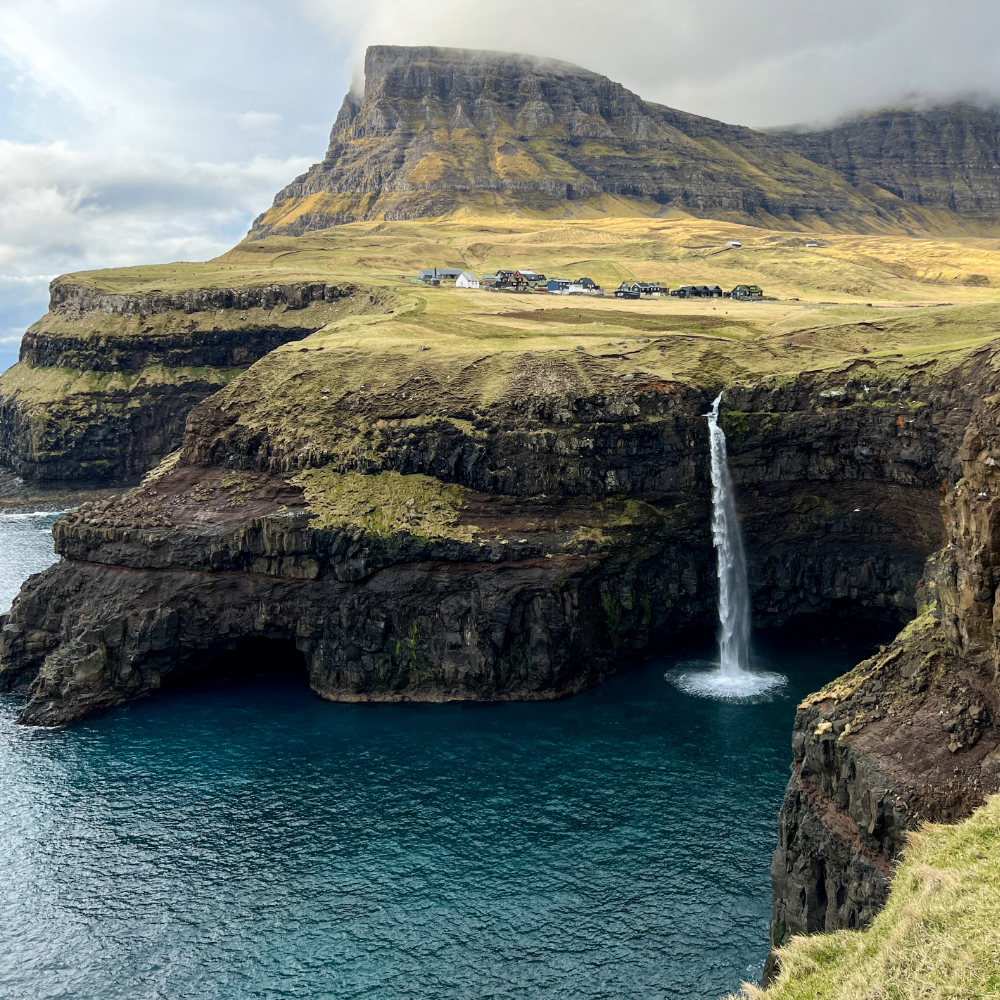
Car rental Torshavn
If you don’t want to rent a car in the Faroe Islands as soon as you land, no problem. It’s possible to catch a bus (or budget-friendly helicopter, if you don’t have a lot of luggage) from Vágar to Tórshavn and organize car rental in the capital if you prefer. That said, there are fewer options in town and many of the offices aren’t really that central. The only real reason this would ever be practical is if you plan to spend a few days just exploring Tórshavn and want to save on the cost of the rental.
The capital is very cute, but there’s a limit to how much stuff you can do. I’ll share some activity suggestions at the end of this article.
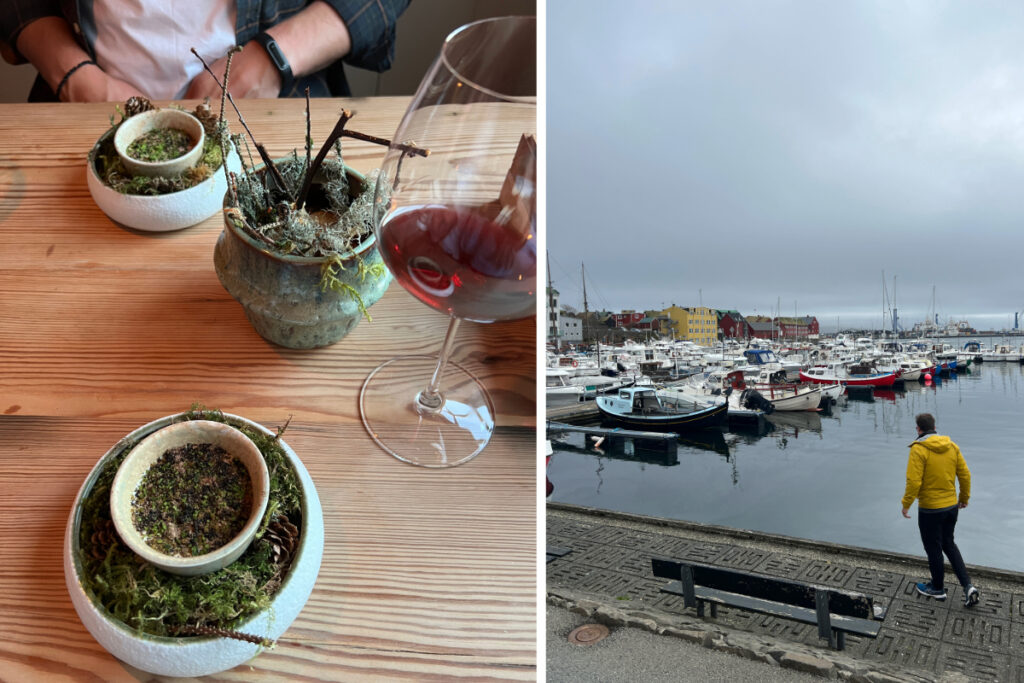
Unique dish at Ræst | Exploring Torshavn harbour
How much does it cost to rent a car in the Faroe Islands?
The cost to rent a car in the Faroe Islands can vary dramatically, but you can expect to spend €500 — €1,500 for a week. Things that affect the price include the type of vehicle you rent, how far in advance you book, and the season you visit. Here are some example bookings compared on DiscoverCars.
- 7-day rental in the peak summer season, booked 1.5 months in advance:
- €775 for a small crossover
- €1,350 for an SUV with AWD
- 7-day rental in the off-season, booked 6 months in advance:
- €500 for a small crossover
- €590 for an SUV with 4WD
I really recommend springing for an SUV if you can. Some adventures will take you along bumpy gravel roads, and even the well-paved ones can get slick when it rains. If you’re visiting in the winter, I’d say this is a non-negotiable. You’ll be thankful for the suspension, better handling, higher vantage point, and 4WD.
I also always book a car with unlimited mileage — who wants to be stressing about how many kilometres they’re driving while on vacation?!
Alternatives if you can't rent a car in the Faroe Islands
Like I said, you kinda need a car in the Faroe Islands. But if you absolutely can’t/won’t drive and you’re still (understandably) determined to visit this beautiful part of the world, there are two other options.
Join a group tour in the Faroe Islands
The main downside of a group tour in the Faroe Islands is just the exceedingly high cost. Private tours? Forget it unless you’re some kinda millionaire.
But, of course, tours come with a lot of benefits. A local guide’s knowledge is unparalleled. They’ll be able to answer questions that come to mind as you explore. And you know they’ll have the insider scoop on the best places to eat or where to find a secret waterfall. If you’re someone who likes having their itinerary taken care of, this might be the way to go so you can just show up and enjoy your holiday. Multi-day trips usually include everything from meals to accommodation and activities, while day trips usually provide transport, a guide, and one or more activities.
If you’re not going to rent a car in the Faroe Islands and plan to get around mostly with public transport, you could mix in some day trips. Many leave from Torshavn, which makes it easy.
Usually I’m pro-Get Your Guide, but Viator has way more tour options in the Faroe Islands. They range from 2-hour boat tours to 10-day all-inclusive excursions.
Use public transport in the Faroe Islands
Public transport will seriously limit your freedom to explore, but it’ll be a fraction of the price of a vehicle. I (obviously) chose to rent a car in the Faroe Islands, so I don’t have firsthand experience with the public transport system. However, I did not see a ton of buses bootin’ around. They exist, but aren’t frequent. The whole population of the Faroe Islands is just over 50,000, so they’re not as needed!
Buses run once every one or two hours. And some routes only operate once a day or on certain days of the week. I suggest going into the public transportation experience with the “slow travel” mindset. Check out the timetables here.
Also, remember these will just get you between major towns. For anything further, you’ll need to walk, cycle, or arrange additional transport (which is not always an option). That said, a 7-day public transport pass gives you unlimited access to buses and ferries and is just 700 DKK (€95). That’s way less than the rental cars!
Don’t let this pretty colourful map fool you — the public transport system won’t be as efficient as the London Underground.
Faroe Islands travel tips and facts
- The Faroe Islands also has its own currency, the Faroese krona. The notes may look different from the Danish krona, but the currencies are intrinsically tied together and are always of equal value. They accept Danish krona, but much of the population wants to separate from Denmark, and I just think it’s more respectful to use Faroese krona whenever possible.
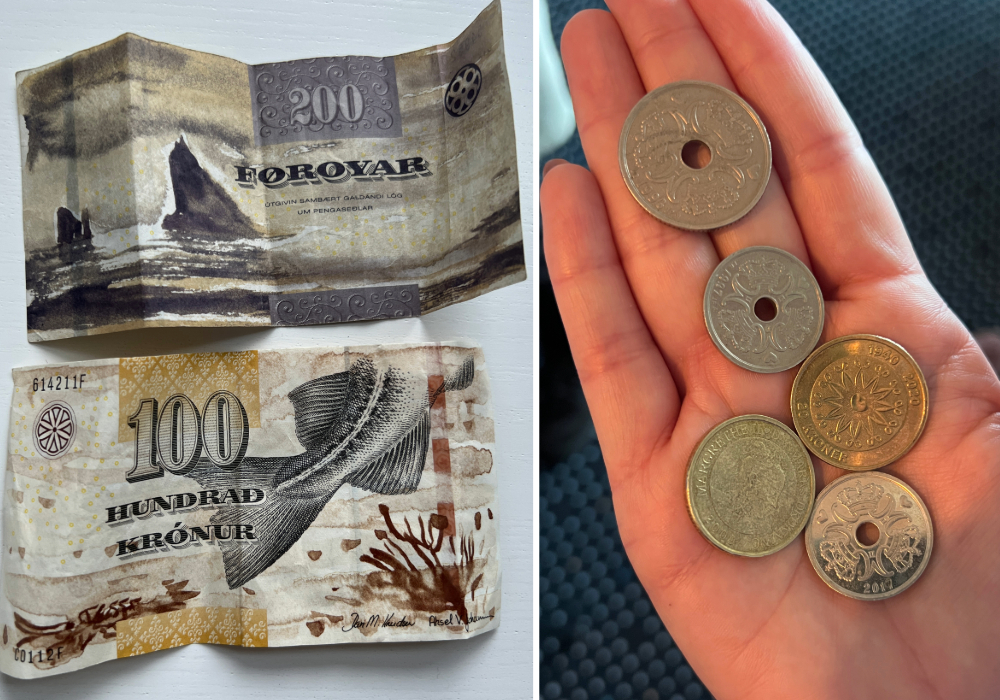
They have their own notes, but use Danish krona coins.
- The Faroe Islands have their own language, Faroese. But Danish is the second official language, and most people learn English in school. Some also speak Icelandic! So it’s a real mixed bag but if you speak English you won’t have any trouble communicating with the locals.
- Speed translates to “fart.” You might notice when you rent a car in the Faroe Islands that there’s a button for “fartpilot.” That’s cruise control. And “fartgrænse” is speed limit. We had a good laugh at this a few times.
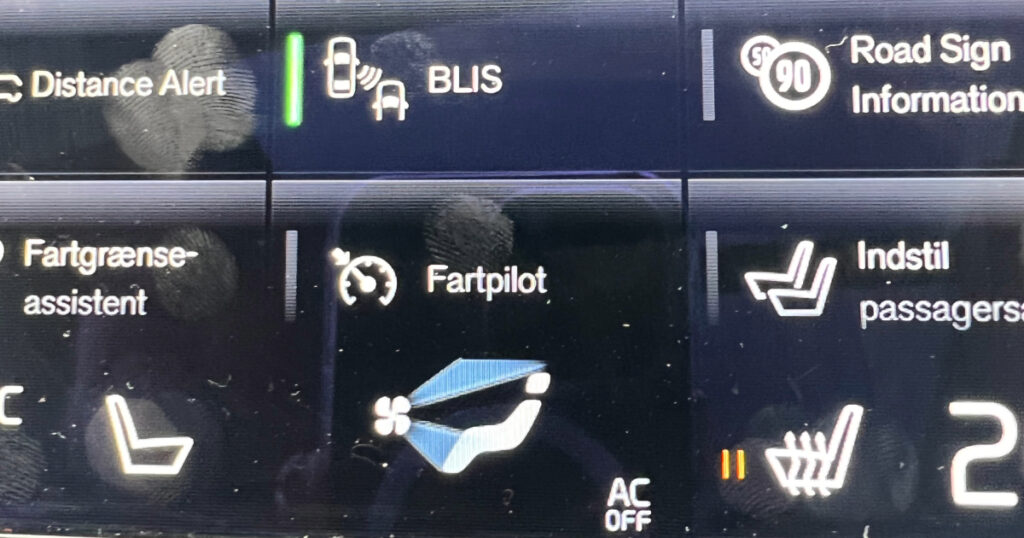
Please excuse the fingerprints on the console
- Dress for the weather. These are volcanic islands in the middle of the Atlantic — they’re rugged, windy, cold, and often rainy. Pack a waterproof jacket, good hiking shoes/boots, and layers you can pile on or strip off as the weather changes. Fortunately, because you’ll have your car, you can leave a bunch of stuff in there so it’s not hard to stay prepared.
- Prepare for hiking fees. Randomly, some popular hiking trails are privately owned and charge a pretty hefty fee for entry. For example, it’s a whopping 200 DKK (€26) to hike Trælanípan, the lake above the ocean. The Faroe Islands are not a budget-friendly destination. But this walk is a must-do activity!
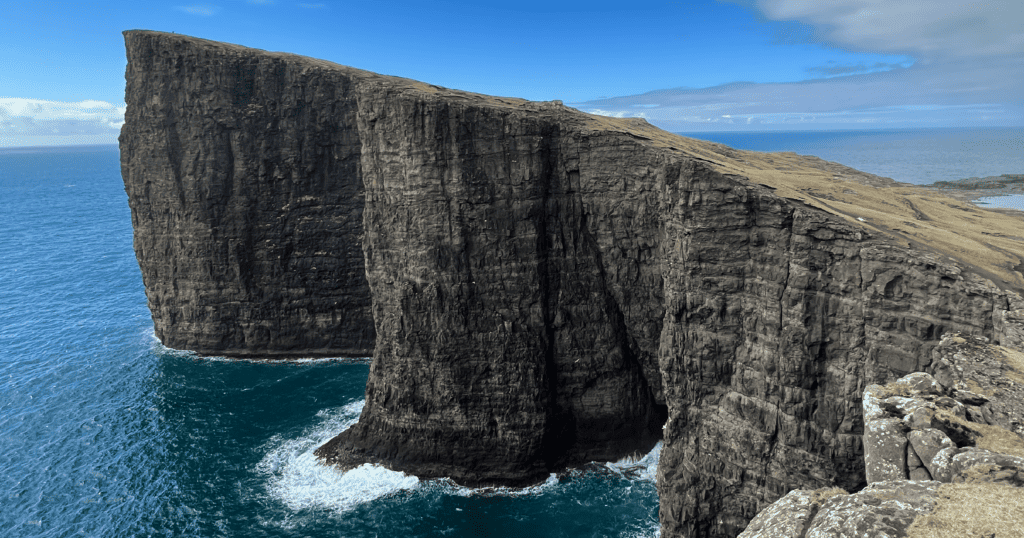
- Book your accommodation ASAP. These little islands aren’t the kind of place you just show up and see what happens. Accom is limited — though there are some very cool options — so it’s best to lock something in as early as you can.
- Take a public transport helicopter. I go into detail about how to do this in another article (below). But basically, because the islands aren’t all connected by road, the Danish government subsidizes the cost of a helicopter as public transport. It’s a cool experience and a very affordable way to see the islands from the sky.
- Stay connected with an eSIM. When you rent a car in the Faroe Islands, or anywhere else for that matter, having a connection to the internet can be a huge lifesaver. If anything goes wrong, you’ll want to be able to contact the rental company. You’ll want to make sure the eSIM you choose has service in the Faroe Islands, not just Denmark.
Activities in the Faroe Islands
- Eat at Ræst. This is a Michelin star-worthy dining experience in Tórshavn and worth every penny. You have to be a bit of an adventurous eater to enjoy it, because most of the food is fermented, but I swear it’s delicious.
- Saksun Village. This is where a car comes in handy — you’ll want to see this picture-perfect village in the northern part of the mainland. Grass-roofed houses perched in front of a waterfall, an old church, and an extensive black sand beach if you’re keen for a walk.
- Vestmanna Cliffs. See the cliffs (and even go inside some caves) on a scenic 2-hour boat tour. This was an unexpected highlight of our trip.
- Kalsoy Mermaid. Take the car ferry and drive out to Mikladalur Harbor on Kalsoy island to see the Kópakonan, or “seal woman” statue. It’s a fun journey and the beautiful statue has some interesting lore behind it.
- Trælanípan. This place is known by a few other names: Slave Cliff, Lake Above the Ocean, and the Bøsdalafossur waterfall is at the end of the trail, pouring from the lake into the ocean. It’s expensive to do the hike, but a must-do activity.
- Kallur Lighthouse. One of my big regrets is that we didn’t have time to do this! The hike looks absolutely incredible, so if you can fit it into your itinerary — do.
- Klaksvik. This is the second-largest city in the Faroe Islands. It’s home to Föroya Bjór, the islands’ main brewery. And the drive between Torshavn and Klaksvik is fun, passing through an interesting tunnel with a roundabout in it.
- Múlafossur. This is the stunning waterfall near the airport that I talked about up there ^. It’s about a 20-minute drive from Vágar and so worth it.
- Spot puffins. The best time to see puffins in the Faroe Islands is from May to August. I went in April and never saw any 🙁 Mykines is the island to visit for this experience. This is one place you’re best off booking a tour. There’s no bridge or tunnel to the island, and an experienced guide can help you spot these little guys.

